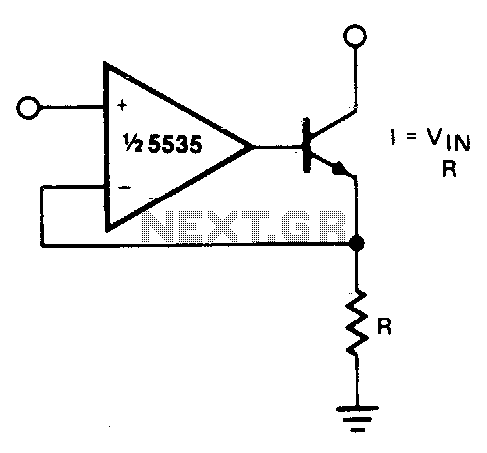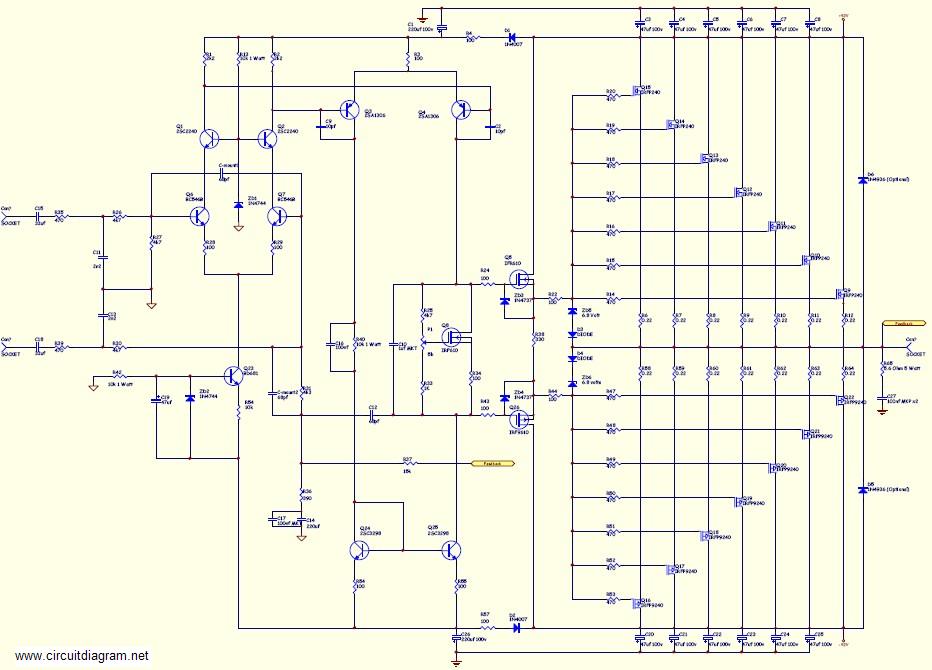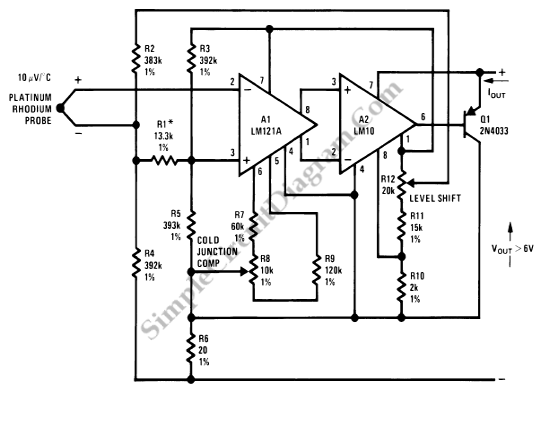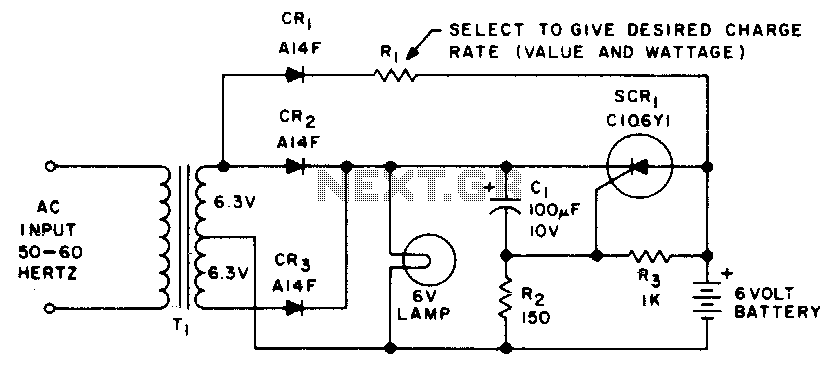
fet current source
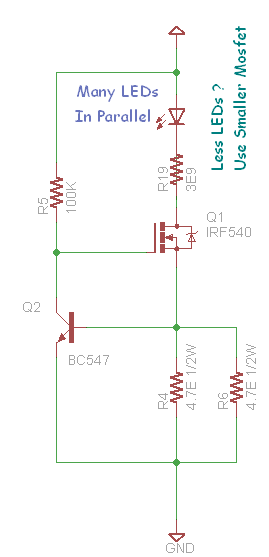
This circuit is a constant current source utilizing a FET, serving as a simple alternative to a series resistor for current limitation. The N-Channel FET BF256C can provide a current of 15mA. Before employing integrated circuits, it is advisable to experiment with various methods to gain a better understanding of LEDs. The first method involves using a single resistor in series to limit the maximum current in a series LED chain. If a regulated supply with a fixed voltage is available, this approach can be implemented. For instance, a supply voltage of 12V minus the LED forward voltage of 9.6V results in a voltage drop of 2.4V across the resistor. To ensure longevity for the LED, a current of 20mA is recommended, as some LEDs can be damaged at 30mA while others can tolerate higher currents. Currently available LED modules can handle currents of 1 to 2A. The power loss in the resistor can be calculated using the formula W = VI, where W represents power in watts. For a current of 20mA and a voltage drop of 2.4V, the power loss is 48mW. Minimizing this loss is crucial to avoid excessive heat generation. If multiple LED chains are created, they can be connected in parallel, utilizing approximately 70% of the SMPS capacity. For example, with 20 strips of three LEDs each, the total current would be 400mA, necessitating a 12V 600mA SMPS. In cases where the supply voltage is unstable, a combination of an SMPS and a resistor, as described, should be used, ensuring the LED chain voltage closely matches the SMPS voltage to minimize heat loss. At lower voltages, the aforementioned method may not be effective, and a MOSFET circuit can be explored. Although transistors can also be used, they tend to generate more heat due to higher voltage drops. When operating on batteries, it is critical to avoid losing even 0.5V, making the MOSFET a suitable choice. This circuit presents an effective design for driving LEDs at low voltage with minimal power loss. When combined with a Joule Thief and PWM (Pulse Width Modulation), various white LED applications such as lanterns and flashlights can be developed. PWM serves to modulate brightness and extend LED lifespan. The key principle is to maintain a constant current for the LEDs to ensure longevity, with high efficiency being achieved through the use of switching MOSFETs. While efficiency may not be a concern for a single LED or two, constant current is non-negotiable due to the importance of adhering to absolute maximum ratings.
This circuit design employs a constant current source configuration using a field-effect transistor (FET), specifically the N-Channel FET BF256C, to regulate the current supplied to LEDs. The primary objective is to maintain a stable current output, which is crucial for the longevity and reliable performance of the LEDs.
The circuit operates by connecting the FET in such a way that it can adjust its resistance based on the current flowing through it. When an LED is connected in series with the FET, the FET dynamically modulates its gate voltage to ensure that the current remains constant, regardless of variations in supply voltage or LED forward voltage drop. This is particularly advantageous in applications where the input voltage may fluctuate, as it prevents overcurrent conditions that could damage the LED.
In practical applications, the circuit can be enhanced by integrating a PWM controller, which allows for brightness modulation of the LEDs. This can be achieved by varying the duty cycle of the PWM signal fed to the gate of the FET, thus controlling the average current delivered to the LEDs. This feature not only provides flexibility in brightness levels but also contributes to energy efficiency, as the average power consumed by the LEDs can be reduced during lower brightness settings.
For larger LED arrays or strips, multiple FETs can be employed in parallel, ensuring that the total current capacity meets the demands of the application. It is essential to calculate the total current requirements based on the number of LEDs and their respective operating currents to select an appropriate power supply unit (PSU). A switch-mode power supply (SMPS) is recommended for its efficiency and ability to handle varying loads, especially in battery-operated devices where power loss is critical.
When designing such a circuit, thermal management must also be considered, as excessive heat generation can lead to component failure. Appropriate heat sinking for the FET and careful layout design can mitigate these risks, ensuring the circuit operates within safe thermal limits.
In summary, the described constant current source circuit using a FET represents an effective solution for LED driving applications, providing stable current control, enhancing LED lifespan, and allowing for brightness modulation through PWM techniques. This design approach is particularly suited for low-voltage applications where efficiency and reliability are paramount.This is a constant current source using a FET. This is the most simple replacement to series resistor to limit current. The N-Channel FET BF256C can give 15mA current. Before you get to use chips, experiment with some methods, which will help you learn about the LEDs better. The first is just One Resistor in series. This is to Limit the max curren t in a Series LED Chain. If you have a Regulated Supply with a Fixed Voltage, then you can use this method. 12V - 9. 6V = 2. 4 V. This is the drop across the Resistor, let us keep the current at 20mA for a Long life for LED. Some LEDs will get damaged at 30mA some take more that that. We now have LED Modules which can take even 1 or 2 A. How Hot W = VI Power in Watts. 20mA x 2. 4V = 48mW. This is where you lose the Money. Keep it low, else the Green Goblin will frown. Unless you want LED Lighting to double up as a Room Heater, Nice idea if you are in the Artic. Now you have a chain of 3 LED with one R, make many such chains and put it in parallel to around 70% of SMPS capacity. If you have 20 Strips of 3 LEDs each, 20 X 20mA = 400mA. You will need a 12V 600mA SMPS. Let us assume, you have a supply that is varying and not stable. Then use a SMPS and Resistor as shown above. Closely matching the LED Chain to the SMPS voltage to keep the heat loss minimum. At Low voltages the above idea may not work. So you can try a MOSFET circuit shown. You can use Transistors too but The Heat is more, as the Drop is more. When you use batteries, you cannot afford to lose even 0. 5V. So the MOSFET is the answer. This circuit is a nice design idea about LED drive with low voltage and watts burden. In combination with a Joule Thief - and PWM you can make many White LED utilities like Lanterns and Flashlights.
PWM is to modulate brightness and also Extend LED Life. The Essence is The LED has to have a long life, constant current is the answer. The Efficiency has to be High, Switching MOSFET is the answer. For just a LED or Two, you do not need to bother about Efficiency, but Constant Current, No Compromise. Why Because it is in the Absolute Maximum Rating. "You do not cross the road, when the light is RED. You do not Drive Faster, than the Speed Limit. You do not Eat, more than you can Digest. You do not Stress the Absolute Max in the Ratings. " 🔗 External reference
This circuit design employs a constant current source configuration using a field-effect transistor (FET), specifically the N-Channel FET BF256C, to regulate the current supplied to LEDs. The primary objective is to maintain a stable current output, which is crucial for the longevity and reliable performance of the LEDs.
The circuit operates by connecting the FET in such a way that it can adjust its resistance based on the current flowing through it. When an LED is connected in series with the FET, the FET dynamically modulates its gate voltage to ensure that the current remains constant, regardless of variations in supply voltage or LED forward voltage drop. This is particularly advantageous in applications where the input voltage may fluctuate, as it prevents overcurrent conditions that could damage the LED.
In practical applications, the circuit can be enhanced by integrating a PWM controller, which allows for brightness modulation of the LEDs. This can be achieved by varying the duty cycle of the PWM signal fed to the gate of the FET, thus controlling the average current delivered to the LEDs. This feature not only provides flexibility in brightness levels but also contributes to energy efficiency, as the average power consumed by the LEDs can be reduced during lower brightness settings.
For larger LED arrays or strips, multiple FETs can be employed in parallel, ensuring that the total current capacity meets the demands of the application. It is essential to calculate the total current requirements based on the number of LEDs and their respective operating currents to select an appropriate power supply unit (PSU). A switch-mode power supply (SMPS) is recommended for its efficiency and ability to handle varying loads, especially in battery-operated devices where power loss is critical.
When designing such a circuit, thermal management must also be considered, as excessive heat generation can lead to component failure. Appropriate heat sinking for the FET and careful layout design can mitigate these risks, ensuring the circuit operates within safe thermal limits.
In summary, the described constant current source circuit using a FET represents an effective solution for LED driving applications, providing stable current control, enhancing LED lifespan, and allowing for brightness modulation through PWM techniques. This design approach is particularly suited for low-voltage applications where efficiency and reliability are paramount.This is a constant current source using a FET. This is the most simple replacement to series resistor to limit current. The N-Channel FET BF256C can give 15mA current. Before you get to use chips, experiment with some methods, which will help you learn about the LEDs better. The first is just One Resistor in series. This is to Limit the max curren t in a Series LED Chain. If you have a Regulated Supply with a Fixed Voltage, then you can use this method. 12V - 9. 6V = 2. 4 V. This is the drop across the Resistor, let us keep the current at 20mA for a Long life for LED. Some LEDs will get damaged at 30mA some take more that that. We now have LED Modules which can take even 1 or 2 A. How Hot W = VI Power in Watts. 20mA x 2. 4V = 48mW. This is where you lose the Money. Keep it low, else the Green Goblin will frown. Unless you want LED Lighting to double up as a Room Heater, Nice idea if you are in the Artic. Now you have a chain of 3 LED with one R, make many such chains and put it in parallel to around 70% of SMPS capacity. If you have 20 Strips of 3 LEDs each, 20 X 20mA = 400mA. You will need a 12V 600mA SMPS. Let us assume, you have a supply that is varying and not stable. Then use a SMPS and Resistor as shown above. Closely matching the LED Chain to the SMPS voltage to keep the heat loss minimum. At Low voltages the above idea may not work. So you can try a MOSFET circuit shown. You can use Transistors too but The Heat is more, as the Drop is more. When you use batteries, you cannot afford to lose even 0. 5V. So the MOSFET is the answer. This circuit is a nice design idea about LED drive with low voltage and watts burden. In combination with a Joule Thief - and PWM you can make many White LED utilities like Lanterns and Flashlights.
PWM is to modulate brightness and also Extend LED Life. The Essence is The LED has to have a long life, constant current is the answer. The Efficiency has to be High, Switching MOSFET is the answer. For just a LED or Two, you do not need to bother about Efficiency, but Constant Current, No Compromise. Why Because it is in the Absolute Maximum Rating. "You do not cross the road, when the light is RED. You do not Drive Faster, than the Speed Limit. You do not Eat, more than you can Digest. You do not Stress the Absolute Max in the Ratings. " 🔗 External reference
